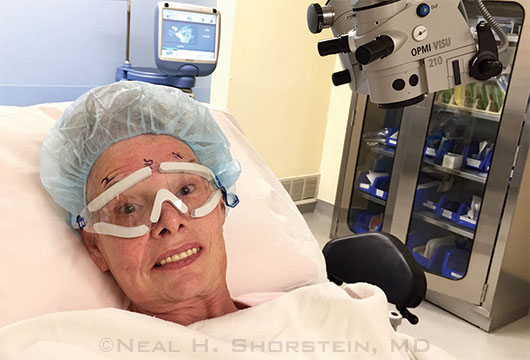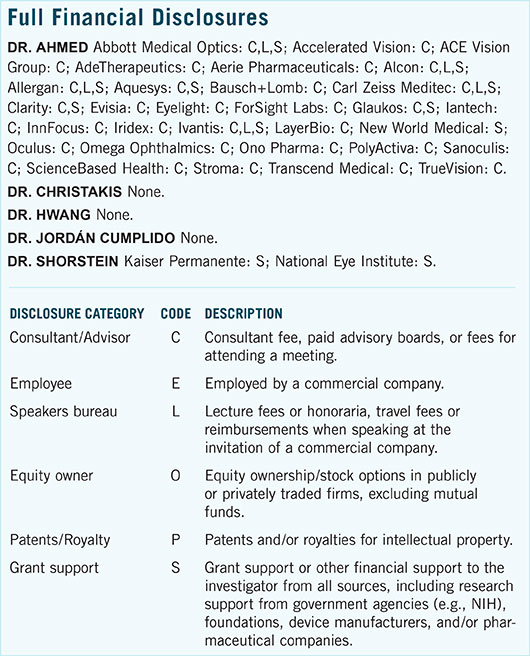Download PDF
Highlighted Paper at AAO 2015: Cataract
An anticipated uptick in patient demand for bilateral same-day cataract surgery (BSD) prompted a team of Kaiser Permanente researchers to assess the risk of operating on both eyes in 1 surgical session. Their finding: With diligent adherence to cleaning and sterilization, coupled with careful IOL selection, BSD can be as safe as unilateral surgery.
Risks and results. To assess the risk, the researchers considered 4,754 BSD surgeries performed from 2009 to 2014 at 21 Northern California Kaiser Permanente surgery centers. They evaluated existing systems for everything from preoperative appointments in the clinic to the chain of events in the operating room leading to implantation of the IOL. Particular attention was paid to adverse outcomes, including incorrect IOL implantation, endophthalmitis, and toxic anterior segment syndrome (TASS).
In these BSD surgeries, 51 eyes (1.1%) developed postoperative macular edema, 1 eye (0.021%) had endophthalmitis, and 1 case (0.021%) involved incorrect lens insertion. There were no significant manufacturer recalls, and there was 1 instance of compounded drug error.1
 |
Bilateral Protection. Clear protective goggles allow patients to function visually after surgery on both eyes.
|
Special challenges. Although complication rates were similar to those reported for unilateral surgery, Neal H. Shorstein, MD, an ophthalmologist and Associate Chief of Quality at Kaiser Permanente in Walnut Creek, Calif., acknowledged that BSD poses unique challenges. “Compared with unilateral surgery, bilateral same-day cataract surgery involves a significant increase in the volume and complexity of data present during a single episode of care,” he said. For example, BSD requires biometric IOL information for 2 eyes instead of 1. “With this comes the potential for system failures to affect both eyes of a single patient.”
To minimize the possibility of such failure, the researchers recommend:
- Better elimination of bioresidue from handpieces with small lumens, perhaps even avoiding use of equipment with small lumens and tips
- Adequately flushing viscoelastic residue from equipment
- Using compounded medicines from separate lots for each eye to prevent bilateral involvement in the rare instance of contamination or dilution error
- Refining and standardizing IOL measurement, selection, and implantation workflow
- Implementing additional safeguards in the preoperative briefing and time-out process to reduce confusion between the eyes
Intracameral antibiotics. Some recommendations, such as cleaning and sterilization to prevent endophthalmitis and TASS, apply to both BSD and unilateral surgery. Specific to BSD is the recommendation to use different lots of compounded intracameral antibiotics in each eye.
Dr. Shorstein, who has been at the forefront of working with intracameral antibiotic injection, previously reported its association with a significant decline in the rate of postoperative endophthalmitis.2 “This innovation has made it feasible and quite reasonable to consider BSD for a broader population of patients,” he said, adding that use of intracameral antibiotic is now standard procedure at Kaiser Permanente for both unilateral and bilateral surgery.
| Bilateral, Same-Day Cataract Surgery: Risk Analysis and Recommendations in a Northern California Eye Department. When: Sunday, Nov. 15, 11:51-11:58 a.m., during the second cataract original papers session (10:15 a.m.-12:30 p.m.); there is also a session on Saturday. Where: Bassano 2701. Access: Free. |
Patient selection. Still, BSD is not for everyone. In patients who have undergone prior corneal refractive surgery, IOL selection is more difficult. And patients with ocular comorbidity, such as diabetic retinopathy, run a higher risk of postoperative macular edema. “The next step for our research group is to determine which patients are most likely to benefit from this emerging modality,” Dr. Shorstein said.
In the meantime, he said, “We now have some preliminary data in the United States indicating that BSD phacoemulsification can be a safe procedure.”
—Miriam Karmel
___________________________
1 Wong DC et al. JAMA Ophthalmol. [Published online July 30, 2015.] doi: 10.1001/jamaophthalmol.2015.2421.
2 Shorstein NH et al. J Cataract Refract Surg. 2013;39(1):8-14.
___________________________
Relevant financial disclosures—Dr. Shorstein: Kaiser Permanente: S; National Eye Institute: S.
For full disclosures and disclosure key, see below.

More from this month’s News in Review